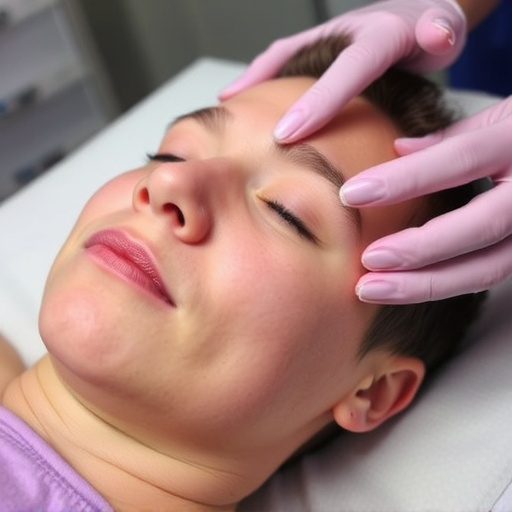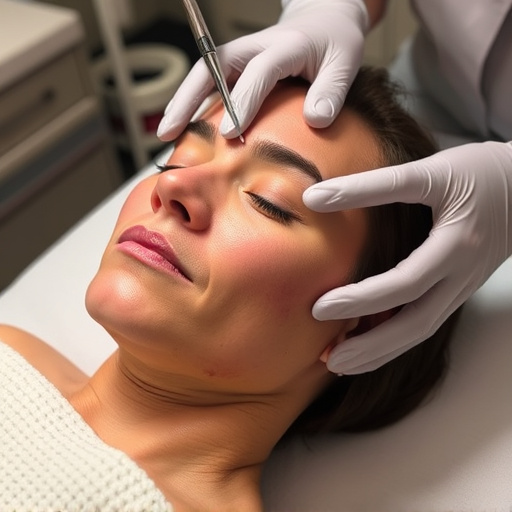Psoriasis Skin Therapy: Accelerating Cell Turnover with Topical Treatments & Lifestyle Changes

Psoriasis skin therapy involves regulating accelerated skin cell turnover caused by a faulty immune…….
Psoriasis skin therapy, a multifaceted approach to managing the complex condition of psoriasis, has emerged as a beacon of hope for millions worldwide suffering from this chronic autoimmune disorder. This comprehensive article delves into the intricate world of psoriasis treatment, exploring various therapeutic modalities, their historical evolution, global impact, and future prospects. By understanding the nuances of this therapy, we aim to empower individuals affected by psoriasis and shed light on the ongoing advancements in dermatological care.
Psoriasis skin therapy refers to a comprehensive set of medical interventions designed to manage and mitigate the symptoms of psoriasis, a disease characterized by rapid skin cell production leading to thick, scaly patches on the skin’s surface. This therapeutic approach encompasses a range of techniques, from topical treatments to systemic therapies, aiming to reduce inflammation, slow down skin cell growth, and alleviate the associated discomfort and psychological distress.
Historically, psoriasis has been documented since ancient times, with references found in Egyptian papyruses dating back to 1550 BCE. However, it was during the mid-20th century that significant advancements in dermatology led to the development of modern psoriasis therapies. The core components of psoriasis skin therapy include:
Topical Treatments: These are applied directly to the affected areas and include creams, ointments, or gels containing active ingredients like corticosteroids, vitamin D3 analogs, or calcineurin inhibitors.
Systemic Medications: Taken orally or injected, these medications suppress the immune system’s overactivity that causes psoriasis flares. Examples include methotrexate, acitretin, and biologic agents.
Phototherapy: Exposing the skin to specific wavelengths of light, often UVB or UVA radiation, helps regulate skin cell production and reduce inflammation.
Suricial Treatments: In severe cases, surgical removal of affected skin patches may be considered to achieve clearer skin.
Psoriasis skin therapy has a profound global impact, affecting millions of individuals across different continents. According to the World Health Organization (WHO), approximately 2-3% of the world’s population suffers from psoriasis, translating to roughly 120-200 million people. The burden of this disease is not limited to physical symptoms but extends to psychological and social impacts, emphasizing the need for effective therapy worldwide.
Key trends shaping the global landscape of psoriasis skin therapy include:
Growing Awareness: Increased public awareness and understanding of psoriasis have led to better acceptance and management strategies, especially in developed regions.
Personalized Medicine: The rise of personalized treatment approaches, leveraging genetic insights and patient characteristics, promises more tailored and effective therapies.
Digital Health Solutions: Mobile apps, telemedicine, and online support groups facilitate patient engagement, education, and remote monitoring of psoriasis symptoms.
Geographic Variations: Regional disparities in access to healthcare, cultural attitudes towards skin conditions, and availability of advanced treatments contribute to varying therapy outcomes across the globe.
The economic implications of psoriasis skin therapy are significant, both for patients and healthcare systems. The global psoriasis treatment market, valued at USD 14.5 billion in 2021, is expected to grow at a CAGR of 6.5% from 2022 to 2030 (Grand View Research). This growth is driven by the increasing prevalence of psoriasis, rising healthcare expenditures, and growing demand for effective, personalized treatments.
Market Dynamics:
Topical Treatments: The market for topical medications dominates due to their wide availability, relatively low cost, and ease of use.
Biologic Agents: High-cost biologic therapies have gained prominence due to their superior efficacy, particularly in severe cases.
Phototherapy Devices: Advances in phototherapy technology have led to improved treatment outcomes and increased adoption.
Investment Patterns: Pharmaceutical companies and biotech startups are heavily investing in psoriasis research, with a focus on novel therapeutic targets and delivery systems. These investments drive innovation, improve treatment options, and ultimately enhance patient quality of life.
Technology plays a pivotal role in transforming psoriasis skin therapy, offering innovative solutions and improved patient outcomes. Some significant advancements include:
Targeted Biologic Therapies: The development of biologic drugs that target specific cytokines or immune cell pathways has revolutionized treatment. These medications provide more effective and durable remissions than traditional systemic agents.
Topical Drug Delivery Systems: Nanotechnology-based formulations and microemulsions enhance the penetration of topical drugs, improving their efficacy and patient compliance.
Digital Therapeutics: Digital platforms and mobile apps enable remote monitoring of skin conditions, provide educational resources, and support patient adherence to treatment plans.
Artificial Intelligence (AI): AI algorithms analyze vast amounts of patient data, helping dermatologists personalize treatment protocols and predict disease progression.
The development and deployment of psoriasis skin therapy are governed by stringent policies and regulations to ensure safety and efficacy. Key frameworks include:
Food and Drug Administration (FDA): In the United States, the FDA evaluates and approves drugs for psoriasis treatment based on rigorous clinical trials.
European Medicines Agency (EMA): The EMA plays a similar role in Europe, assessing and authorizing medicines for market use across member states.
Global Harmonization: International organizations promote harmonized regulations to facilitate the global accessibility of approved treatments while ensuring quality standards.
Regulatory bodies continuously monitor the safety profile of psoriasis therapies, especially as new biologic agents and targeted treatments emerge. This oversight is crucial in managing potential adverse effects and maintaining public trust in dermatological care.
Despite significant advancements, psoriasis skin therapy faces several challenges and criticisms that hinder its full potential:
Cost and Accessibility: High-cost biologic therapies and specialized treatments limit access for low- and middle-income patients, leading to treatment disparities.
Side Effects: All medications carry the risk of adverse effects, and finding the right balance between therapy and tolerability remains a challenge.
Patient Adherence: Complex treatment regimens, including frequent applications or injections, can lead to patient non-adherence, impacting treatment outcomes.
Lack of Standardized Protocols: Variability in treatment approaches across healthcare providers may result in inconsistent outcomes, emphasizing the need for standardized guidelines.
To address these issues, collaborative efforts between healthcare providers, payers, and regulatory bodies are essential. Strategies to improve access, enhance patient education, and develop more cost-effective treatments can help overcome these challenges and ensure better care for psoriasis patients.
The following case studies illustrate the practical application of psoriasis skin therapy and highlight its transformative potential:
Case Study 1: Samantha’s Journey to Clear Skin
Samantha, a 32-year-old marketing professional, struggled with moderate to severe psoriasis for over a decade. Through a comprehensive approach involving topical medications, UVB phototherapy, and regular follow-ups with her dermatologist, Samantha achieved clear skin within a year. This success story underscores the effectiveness of personalized therapy combining various modalities.
Case Study 2: David’s Battle with Severe Psoriasis
David, a 58-year-old retired teacher, was diagnosed with severe psoriasis covering over 50% of his body surface area. He responded well to a combination of systemic medication (acitretin) and biologic therapy (infliximab). After two years of treatment, David experienced significant improvement, significantly enhancing his quality of life and psychological well-being.
Case Study 3: A Community-Based Intervention
In a rural area with limited access to specialized dermatology care, healthcare professionals implemented a community-based psoriasis management program. This initiative included patient education workshops, group support sessions, and telemedicine consultations. The program successfully improved patient adherence to treatment and reduced the burden of psoriasis on affected individuals and their families.
The future of psoriasis skin therapy is filled with promising possibilities as research and innovation continue to shape this field. Several emerging trends and growth areas include:
Personalized Medicine: Further integration of genetic testing, AI algorithms, and patient data analytics will enable more tailored treatment approaches, improving outcomes and reducing side effects.
Targeted Therapies: Advancements in understanding immune pathways involved in psoriasis will lead to the development of novel targeted therapies with fewer adverse effects.
Telehealth and Digital Solutions: The integration of telemedicine, digital health platforms, and mobile apps will expand access to care, especially in underserved regions, and facilitate remote monitoring and patient education.
Combination Therapies: Combining different treatment modalities, such as phototherapy with topical medications or biologic agents, may offer synergistic effects, leading to faster and more durable remissions.
Psoriasis skin therapy represents a complex yet dynamic field, constantly evolving to meet the diverse needs of individuals affected by this chronic condition. From historical roots to modern-day innovations, the therapeutic landscape has witnessed remarkable advancements. As we look ahead, the focus remains on improving patient outcomes, enhancing access to care, and fostering a better understanding of psoriasis.
By addressing the challenges and harnessing the potential of emerging technologies, healthcare professionals and researchers can unlock new frontiers in psoriasis management. The ultimate goal is to enable individuals with psoriasis to lead fulfilling lives, free from the burdens of this complex skin condition.
Q: How do I know if my skin condition is psoriasis?
A: Psoriasis is characterized by thick, scaly patches on the skin that can be itchy and painful. If you notice these symptoms, consult a dermatologist for a proper diagnosis through a medical history review and physical examination.
Q: Are there any home remedies for psoriasis?
A: While some natural remedies may provide temporary relief, there is no cure for psoriasis at home. Topical treatments and prescribed medications are essential for effective management under professional guidance.
Q: How often should I expect to see results from psoriasis therapy?
A: Treatment outcomes vary depending on the severity of your condition and the chosen therapy. Some topical treatments may show improvements within weeks, while others, like biologic agents, might take several months to achieve noticeable results.
Q: Can psoriasis be cured completely?
A: Currently, there is no permanent cure for psoriasis. However, with sustained treatment and proper management, many individuals can achieve long-term remission or significantly reduce the frequency and severity of flare-ups.

Psoriasis skin therapy involves regulating accelerated skin cell turnover caused by a faulty immune…….

Psoriasis, a chronic autoimmune condition causing accelerated skin cell production, requires managem…….

Psoriasis skin therapy combines personalized treatments like facials and body contouring with tradit…….

Understanding skin type is crucial for effective psoriasis skin therapy. Personalized treatments usi…….

Psoriasis is a chronic autoimmune condition causing skin cell overproduction and thick, scaly patche…….

Psoriasis skin therapy focuses on gentle, specialized treatments for sensitive areas affected by pso…….

Psoriasis skin therapy involves a multi-faceted approach combining topical medications, systemic tre…….

Psoriasis skin therapy has evolved, treating beyond visible plaques to address underlying inflammati…….

Psoriasis skin therapy involves a personalized routine combining gentle cleansing, exfoliation, topi…….

Psoriasis is a complex autoimmune condition causing accelerated skin cell growth and visible scaly p…….